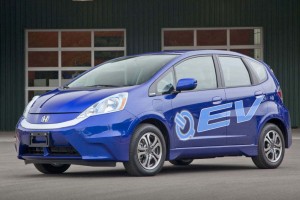The new Honda Fiat EV has landed a 118 MPGe federal fuel economy rating, the highest ever granted by the Environmental Protection Agency.
Scheduled to go into limited distribution over the summer the 2013 Fit EV is Honda’s first battery-electric vehicle in two decades and enters a fast-emerging market segment that will soon include offerings from most of the major automakers – as well as new start-ups like California’s Tesla Motors.
The EPA’s Combined 118 MPGe rating shoots Honda past the Mitsubishi i-MiEV, at 112 MPGe, the Ford Focus Electric, at 105 MPGe, and the Nissan Leaf, rated at 99 MPGe.
The rating, short for Miles Per Gallon-equivalent, is a means of comparing the energy used by a battery-based vehicle in terms comparable to what a motorist might expect were the vehicle running on conventional gasoline. It is calculated by dividing the distance traveled by the amount of energy used. The EPA calculates that one gallon of gasoline is equal to 33.7 kilowatt hours of electric energy stored in a vehicle’s battery pack.
In the case of the Fit EV, the Honda electric vehicle has a 20 kilowatt-hour, or kWh, lithium-ion battery pack, equal to only about 0.6 gallons of gas. But it can travel an average 82 miles on that before needing a recharge, according to EPA tests. Do the math and it works out to that 118 equivalent miles per gallon.
In terms of range, the 2013 Honda Fit EV also comes out on top when compared to the estimated 76 miles for the Focus Electric, 73 miles for the Nissan Leaf and just 62 miles for the Mitsubishi i-MiEV.
Of course, as with gasoline-powered vehicles, size matters and the Fit is smaller than all its battery competitors except for the Mitsubishi. Honda officials also emphasize they boosted range by reducing weight and focusing on improving the Fit EV’s aerodynamics.
Honda claims the new battery-electric vehicle can recharge in just three hours. That figure, of course, relies on having access to a 220-volt circuit with high enough amperage.
The 3-mode electric drive system produces a maximum 123 horsepower and 189 lb-ft of torque, which Honda Environmental Business Office Vice President Steve Center promises will be “an absolute kick to drive.”
Since electric motors generate maximum torque the moment they start spinning they generally deliver good off-the-line acceleration, though they also start running out of steam, in most cases, by the time they’ve hit about 30 mph.
And aggressive driving – along with the use of electric heat or air conditioning – will rapidly reduce battery range.
Unveiled at the Los Angeles Auto Show last November, Honda plans only limited distribution of the Fit EV, the vehicle to go on sale in California and Oregon in the coming months. It will be rolled out in East Coast markets in 2013.

